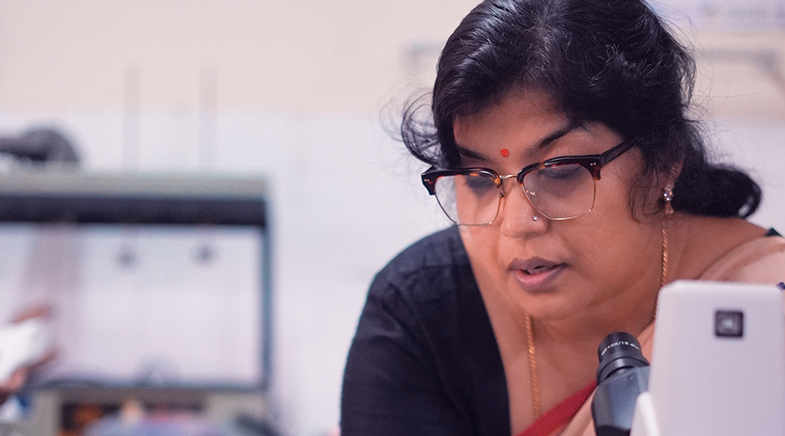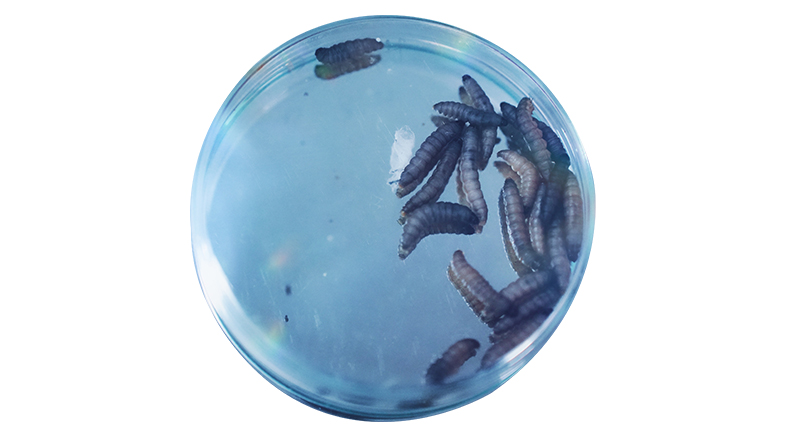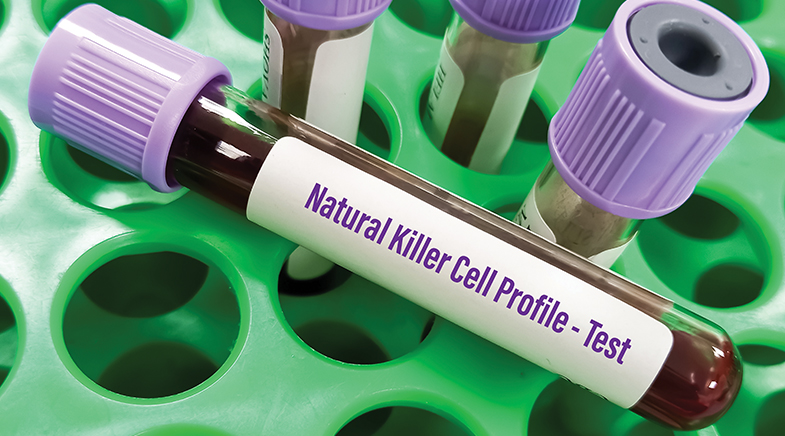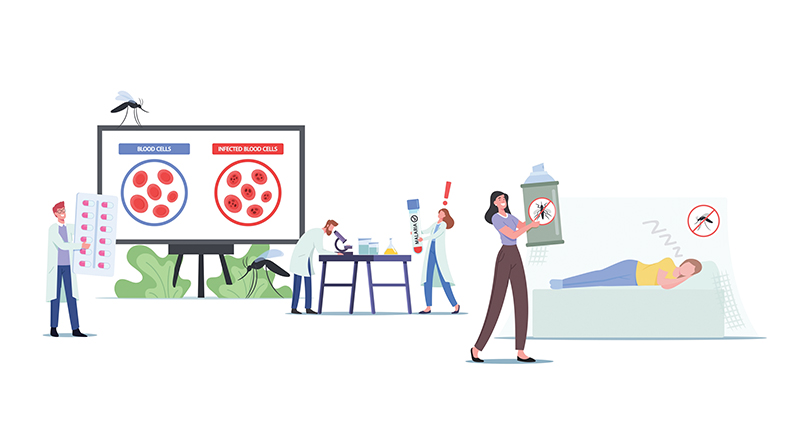Degrading microplastics with bacterial cocktails
-
- from Shaastra :: vol 02 issue 01 :: Jan - Feb 2023

Scientists are formulating bacterial consortia, searching for new sources of enzymes and engineering bacteria and protein to degrade plastic.
N.V. Vinithkumar watched in dismay as plastic piled up on the otherwise pristine beaches of Andaman and Nicobar. He had seen the gradual increase in plastic accumulating on the islands, a remote yet popular tourist destination, since joining the Port Blair-based centre of the National Institute of Ocean Technology in 2005.
Not surprisingly, the scientist is now looking at ways to degrade plastic.
Plastic comes in various shapes, sizes, and chemical compositions, and each kind requires a different approach to degradation. Plastic carry bags and other such products often break down into tiny plastic particles called microplastics, which get ingested by animals and enter the food chain.
Vinithkumar and a group of scientists, studying the effects of plastics on ocean animals and the food chain, recently reported in the journal Science of the Total Environment (bit.ly/microplastics-ocean) that microplastics were being ingested by zooplanktons. This poses a serious problem as zooplanktons are eaten by fish larvae. The larvae, however, are unable to digest microplastics, which often lead to their death. As fish are an integral part of the marine food chain, the rise in microplastic levels in oceans can cause severe food chain disruptions.
As a marine biologist, Vinithkumar has been examining marine microbes for a long time and was aware of their ability to survive in harsh and polluted environments. Though the bacteria dwell on and degrade any type of waste, this process is slow in the natural environment.
It was important, he felt, to identify the bacteria involved in degradation processes. "In the natural environment, plastic-degrading bacteria compete with other bacteria, and degradation is limited. But in an experimental and testing environment, there is no interference from other bacteria, and degradation is faster," Vinithkumar says.
Along with other researchers, he decided to isolate the microbes that feast on the island's plastic waste. They found out that around 100 types of bacteria thrived on this waste. The scientists then identified bacterial species that had a better ability to degrade low-density polyethylene. These bacteria use plastic as a carbon source or food and degrade it in this process.
The team then made a cocktail of four of these bacterial types and tested them for their efficiency in degrading plastic. They found that the cocktail was faster at degrading plastic than any single bacterial species.
The consortia approach benefits from the different strengths of different bacteria in degrading different plastic intermediates. Each bacterial species may use a different mode of action or a different set of enzymes to degrade plastic.
Combining the varying strengths of a group of bacteria helps in achieving faster degradation or degradation of various plastic forms together. Such powerful bacterial concoctions can then be sprayed directly on the plastic waste or used to clean wastewater of microplastics.
ENGINEERING ENZYMES
While some scientists are testing bacterial combos to hasten the process of plastic degradation, Pravindra Kumar from the Indian Institute of Technology Roorkee is focusing on plastic-degrading enzymes.
"Until we know the mechanism of plastic-degrading enzymes, we cannot engineer better bacteria for plastic degradation," Kumar says.
In his laboratory, he has been studying enzymes to understand their mode of action and tinkering with them to enhance their rate of reaction or to increase the number of substances they can act on.
An enzyme is essentially a protein made up of an array of amino acids that dictate its 3D structure and, thereby, function. Scientists modify the amino acids of enzymes to observe the change in their structure and function. These tweaks allow the researchers to understand the enzyme functioning better, and, in the process, generate enzymes that have potential industrial applications.
Kumar and his team worked on three bacterial enzymes involved in the bio-degradation pathway of polyethylene terephthalate (PET). PET is commonly used to make bottles and containers for storing liquid and food. These single-use plastic products can take more than 100 years to break down. The team has elucidated the structure of these enzymes, showing how they work and the key amino acids that are involved in carrying out the degradation reaction.
With this fundamental knowledge, the group came up with tweaked enzymes that degrade intermediates of the PET degradation pathway faster than naturally occurring enzymes. Using enzymes directly for plastic degradation, however, is not cost-effective, so the team is now engineering these lab-generated enzymes into a bacterium with the aim of getting organisms that degrade PET speedily.
This approach — isolating plastic degrading enzymes from bacteria, studying their properties, engineering them for faster reactions, and engineering them back in bacteria — is being used by many scientists working on ways to end the Earth's plastic pile-ups. Professor John McGeehan's team at the University of Portsmouth, for instance, has created a cocktail of two PET-degrading enzymes; it cuts down plastic six times faster than naturally occurring enzymes.
Devipriya works on the premise that "nature always has a solution...We have to observe so keenly that nature speaks to us."
Laboratories are also sequencing plastic-degrading bacteria, performing genomics and transcriptomics to identify plastic-degrading genes and understand the mechanism employed by different organisms to degrade bacteria. Such insights will help them engineer metabolic pathways in different bacteria. Doongar Chaudhary's laboratory in CSIR-Central Salt and Marine Chemicals Research Institute is using a similar approach to get more insights into the plastic degradation process.
NOT JUST MICROBES
While some scientists are dealing with enzymes, researchers such as Suja P. Devipriya are scouting for organisms that degrade plastic or similar substances in nature to learn the degradation method from them and identify new enzymes and pathways of plastic degradation.
"I used to teach a course on industrial ecology, which is based on the premise that nature always has a solution; we have to observe so keenly that nature speaks to us," says Devipriya, Associate Professor at the Cochin University of Science and Technology.
While looking for substances that are similar to plastic in their chemical structure, Devipriya stumbled upon a beeswax comb that is akin to polyethylene. In nature, the beeswax comb is eaten by waxworms and darkling beetles, which infest beehives. Based on this knowledge, Devipriya decided to study the lesser waxworm (Achroia grisella) and a species of the darkling beetle for their ability to eat and degrade plastic. The waxworm was given high-density polyethylene to feed on, and the beetle was given polystyrene. As anticipated, both the waxworm and beetle chewed their respective feeds and were able to complete their lifecycles on their respective feeds.

Since it is not feasible to use them on a large scale, scientists have been seeking to identify the mechanism of plastic degradation by these organisms. Initially, it was believed that the microbes residing in their gut were responsible for their plastic-degrading capabilities, but last year a Spain-based research group working on another species of waxworm showed that enzymes present in the saliva of waxworms had plastic-degrading capabilities.
These new enzymes have ignited the curiosity of researchers, who are now looking for plastic-degrading properties in other organisms. Other than bacteria, waxworms and beetles, certain species of microalga, cyanobacteria and fungus, and mealworms have demonstrated plastic-degrading properties.
While scientists continue to look for effective plastic destroyers, waste is piling up. While biodegradable plastics have entered the market, there is no scalable solution yet to clean the burgeoning plastic waste. Though incineration and chemical treatment are other means of degrading plastic, these approaches are not environment-friendly. Scientists thus anticipate that the solution to the plastic problem will come from biotechnology. But till that happens, minimising plastic production and use is the only way forward.
DEATH BY PLASTIC
The effect of microplastic on human health.
Microplastics can enter the human body through the inhalation of nano-plastics and microplastics in the air, by eating marine organisms, or through skin contact. Studies have shown the presence of microplastics in almost all human organs including the human placenta. While there are limited studies on the effects of microplastic on humans, research on mice and other animals underlines the fact that microplastics can cause immune disorders and failure.
They also interfere with metabolic enzymes, leading to high energy expenditure and disruption in normal metabolism cycles. Microplastics in the liver, kidney and gut impair the function of these organs. Tiny particles have also been shown to impact neuronal function and behaviour, increasing the risk of neurodegenerative diseases. They are endocrine disruptors and their ability to damage the DNA points to their role in causing cancer.
See also:
Have a
story idea?
Tell us.
Do you have a recent research paper or an idea for a science/technology-themed article that you'd like to tell us about?
GET IN TOUCH














